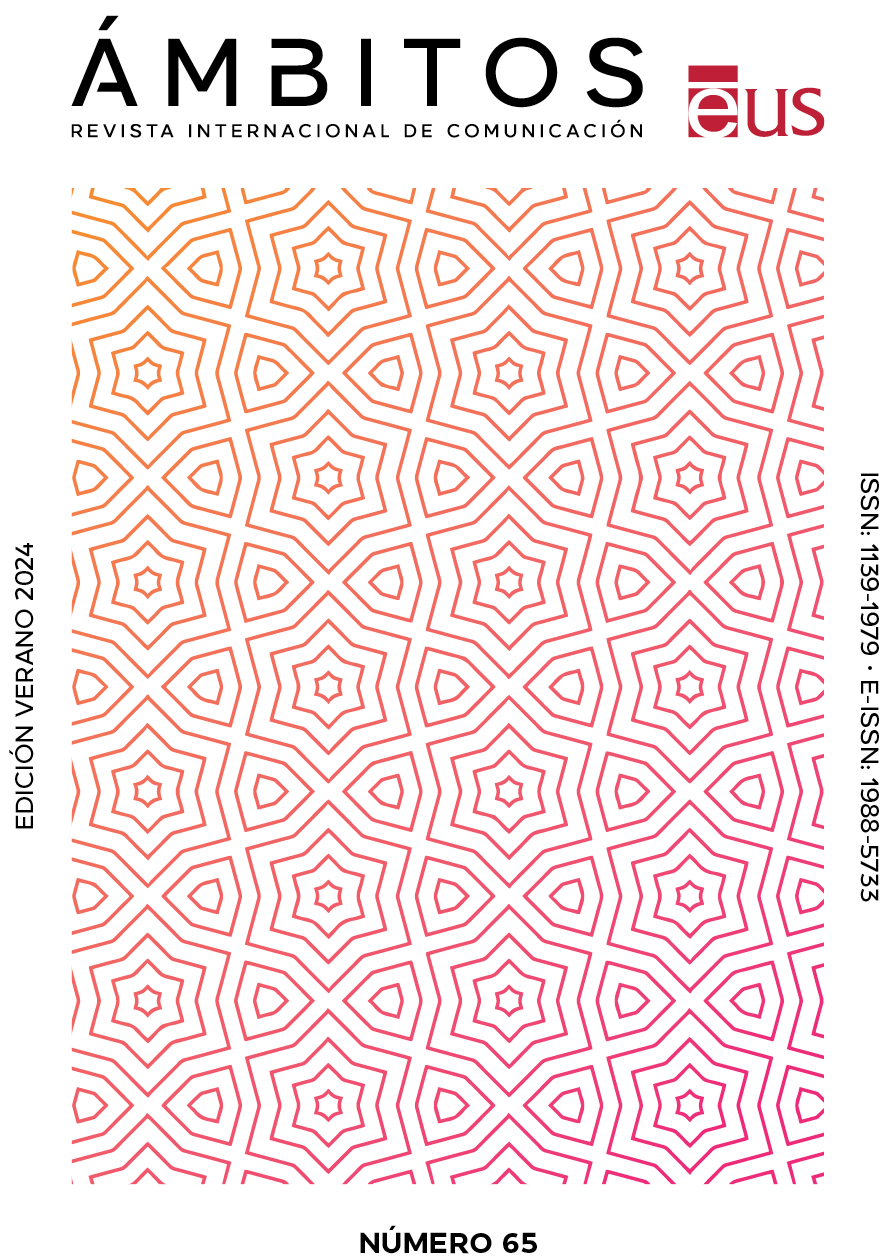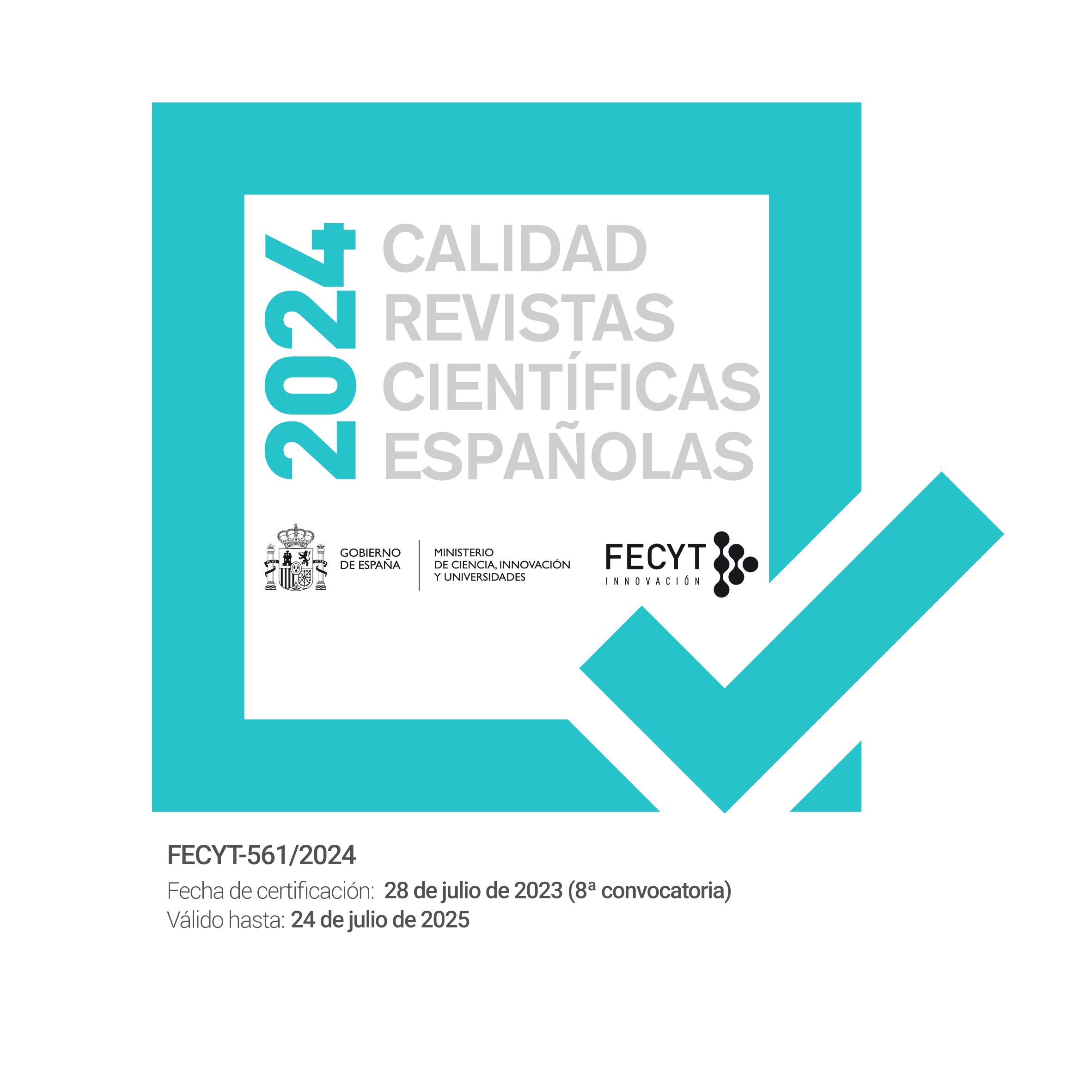El periodismo como medio de fijación término-conceptual: el caso de El País durante la cobertura de las revueltas árabes de 2011
DOI:
https://doi.org/10.12795/Ambitos.2024.i65.08Palabras clave:
revueltas árabes, periodismo, El País, Primavera ÁrabeResumen
Ante un acontecimiento de resonancia internacional, el periodismo se erige en catalizador e, incluso, acuñador de conceptos y percepciones. Las revueltas árabes de 2011 presentan el paradigma de fijaciones término-conceptuales en la prensa. La expresión Primavera Árabe es, por antonomasia, el ejemplo más evidente de tal acuñación conceptual, amén de otras cuestiones de mayor sensibilidad para los lectores como la subida al poder del «islam político» o la ensalzada figura de Mohamed Bouazizi, el vendedor ambulante quemado a lo bonzo el 17 de diciembre de 2010 por su situación socioeconómica. Sin embargo, investigadores varios desmitifican la imagen de Bouazizi y rebautizan las revueltas como otoño o invierno árabe. Esta investigación indaga las terminologías y las locuciones prevalecientes en los géneros informativos de la sección internacional de El País durante el tratamiento de las revueltas árabes de 2011 para lo que se realiza un análisis sobre 1200 textos. De la mano de un método mixto –cuantitativo y cualitativo– se examinan los conceptos que este diario utiliza con frecuencia para condicionar la agenda pública sobre este acontecimiento internacional. Los resultados indican que El País se ha hecho eco, aunque tardíamente, del neologismo: Primavera Árabe. Esta demora en incluirlo dentro de la nomenclatura definitoria de tales sucesos se atribuye a que la cabecera madrileña opte por aguardar un atisbo de la consolidación de los logros obtenidos en Túnez y Egipto, así como su contagio a otras naciones para poder catalogar estos hechos como una Primavera Árabe.
Descargas
Citas
Abdel Sattar, K.A.I. (2015). La Problemática relación entre religión y política en el pensamiento político
occidental. Iraqi Academic Scientific Journals, (42), 315-338. Autor y título en su idioma original
خالد عبدالاله عبدالستار، إشكالية العلاقة بين الدين و السياسة في فالفكر السياسي الغربي
https://www.iasj.net/iasj/article/117618
Alamoush, B. (2021). La relación entre religión y política en el islam. Revista jordana en los estudios islámicos, 17(3), pp. 75-90. https://search.emarefa.net/detail/BIM-1371256 Autor y título en su idioma original
بسام العموش، علاقة السياسة بالدين في الإسلام
Al Ghuraifi, S. M. (2023). The relationship between monotheism and politics in the Holy Quran. Journal of Contemporary Quranic Studies, (2), 87-110. https://doi.org/10.22034/DQM.2023.7602
Álvarez-Ossorio Alvariño, I. (2012). Primavera democrática árabe: ¿otoño islamista? En M. Mesa (coord.), Cambio de ciclo: crisis, resistencias y respuestas globales. Anuario 2012-2013, Nº 6 (pp. 107-122). CEIPAZ-Fundación Cultura de Paz.
Atwan, J. A., & Hatim Oulwan, I. (2010). Los límites de la democracia (una mirada a la relación entre religión y poder político). La revista política e internacional, (16), 35-61. Autor y título en su idioma original
( خضر عباس عطوان و ابتسام حاتم علوان، حدود الدیمقراطیة (نظرة في علاقة الدین والسلطة السیاسیة
Banco Mundial. (2019). Tasa de mortalidad por suicidio. https://acortar.link/JFDeS4.
Bassets, L. (2012). El año de la revolución: cómo los árabes están derrocando a sus tiranos. Santillana Ediciones Generales, S.L.
Ben Jelloun, T. (2011). La primavera árabe: el despertar de la dignidad. Alianza Editorial, S.A.
Ben Mohammad Safar, H. (2012). La política jurídica en la reserva de los tratados en el derecho internacional y las leyes del derecho islámico: el Reino de Arabia Saudita como modelo. Revista de investigaciones jurídicas y económicas, 50(1), 273-351. Autor y título en su idioma original
حسن بن محمد سفر، السياسة الشرعية في التحفظ على المعاهدات في القانون الدولي و أحكام الشريعة الإسلامية المملكة العربية السعودية نمودجا
https://doi.org/10.21608/mjle.2011.158006
Bensaada, A. (2015). Arabesque: enquête sur le rôle des États-Unis dans les révoltes arabes. Investig’Action.
Bourgou, T. (2012). Les États-Unis, les pétromonarchies et les révoltes arabe. En E. Denécé (dir.), La face cachée des révolutions arabes (pp. 343-358). Ellipses Édition Marketing S. A.
Brahimi El Mili, N. (2012). Le printemps arabe: une manipulation? Max Milo.
Bramon, D. (2017). El islam político. España. Los Libros de La Catarata. https://acortar.link/tQQIML
Cea D’ancona, Á. (1996). Metodología cuantitativa: estrategias y técnicas de investigación social. Síntesis.
Collon, M. (2014). Serons-nous toujours «une guerre en retard»? Prólogo en A. Bensaada, Arabesque: enquête sur le rôle des États-Unis dans les révoltes arabes (pp. 17-24). Investig’Action.
Darius Nazemroaya, M. (2013). Un panorama de caos en el mundo árabe. Rebelión.
Denécé, E. (2012). La grande illusion des “révolutions” arabes. En E. Denécé (dir.), La face cachée des révolutions arabes (pp. 9-36). Ellipses Édition Marketing S. A.
El Madkouri Maataoui, M. (2006). El otro entre nosotros: el musulmán en la prensa. En M. Lario Bastida (coord.). Medios de comunicación e inmigración (1ª ed.) (pp. 97-124). Convivir sin racismo.
Étienne, B. (1996). El islamismo radical. Siglo XXI de España.
Gómez García, L. (2009). Diccionario de islam e islamismo. Espasa Calpe.
Goytisolo, J. (2012, 22 de enero). De la primavera al otoño árabe. El País Semanal. https: //elpais.com/diario/2012/01/22/eps/1327217214_850215.html
Guilmain, O. (2012). L’influence des ONG américaines sur le printemps arabe: l’exemple de la National Endowment for Democracy. En E. Denécé (dir), La face cachée des révolutions arabes (pp. 385-414). Ellipses Édition Marketing S. A.
Haddad, M. (2012). Genèse et finalité de la «révolution du jasmin». En E. Denécé (dir), La face cachée des révolutions arabes (pp. 39-98). Elipses Édition Marketing S. A.
Hadjar Kherfane, A. (2015). La primavera árabe: el caso de Túnez a través de la prensa. Tesis doctoral. Universidad de Sevilla. http://hdl.handle.net/11441/26833
Hroub, K. (2015). Los medios de comunicación (sociales), la política y el momento de la Primavera Árabe. Quaderns de la Mediterrània, (22), 314-319.
Huntintong Samuel, P. (2002). ¿Choque de civilizaciones? Tecnos.
Igartua Personaz, J. J. (2006). Métodos científicos de investigación en comunicación. Bosch.
Izquierdo Brichs, F. (2011). Islam político en el siglo XXI. Revista CIDOB d’Afers Internacionals, (93-94), 11-32. https://www.jstor.org/stable/25822775
Krippendorff, K. (2004). Content analysis. An introduction to its methodology. SAGE Publications
López García, B. (2013). Paradojas y desafíos de las primaveras árabes. Res pública: Revista de Filosofía Política, (30), 147-162.
Majdoubi, H. (2012). Revolución por la dignidad en el mundo árabe. Icaria editorial, s. a.
Massad, J. (2012, 29 de agosto). The ‘Arab Spring’ and other American seasons. Aljazeera. https://www.aljazeera.com/opinions/2012/8/29/the-arab-spring-and-other-american-seasons.
Meyssan, T. (2014). John McCain, el organizador de la “primavera árabe” y el Califa. Red Voltaire.
Owen, B. (2012). Indroduction. En B. Owen (dir.), La société civil: un cheval de Troie? (pp. 13-15). Studyrama.
Paz, O. (1968). Corriente alterna. Siglo XXI Editores, S. A.
Pipes, D. (2011). “arab spring”: misnomer. National Review. https://www.nationalreview.com/corner/arab-spring-misnomer-daniel-pipes/.
Reinaldo, M. (2014). Túnez: logros y obstáculos en la senda de la transición. En P. González Del Miño (ed.), Tres años de revoluciones árabes (pp. 98-115). Los libros de la Catarata.
Reinares, F. (2011). ¿Se convertirá Libia en una nueva Somalia? La hipótesis de un escenario yihadista tras el enfrentamiento civil. Real Instituto Elcano, (50), 1-5.
Rguig, S. (2019). La representación de la Primavera Árabe en los medios de comunicación estadounidenses. Relaciones Internacionales, (42), 77-94. https://doi.org/ 10.15366/relacionesinternacionales2019.42.005
Ruiz González, F. J. (2012). De la primavera árabe al Invierno Islamista. ¿Está actuando Occidente conforme a sus intereses? Fundación Ciudadanía y Valores.
Saadi Haddach, O., & Zurbano Berenguer, B. (2012). La representación de la mujer egipcia en los medios de comunicación durante la primavera árabe. Un acercamiento a la (ir)realidad construida. En B. Zurbano-Berenguer (coord.), Mujeres en Oriente Medio: agentes de desarrollo en un contexto de conflicto (pp. 160-188). Asociación Universitaria Comunicación y Cultura. http://hdl.handle.net/11441/24753
Shawki, Y. (2014). El despertar árabe, ¿sueño o pesadilla? Universidad de Santiago.
Soengas, X. (2013). El papel de Internet y de las redes sociales en las revueltas árabes: una alternativa a la censura de la prensa oficial. Comunicar. Revista Científica de Comunicación y Educación, (41), 147-155. https://doi.org/10.3916/C41-2013-14
Tahar Chaouch, M. (2012). A propósito de Libia, la primavera árabe y otras rebeliones del mundo. La Palabra y el Hombre, Tercera época, (19), pp. 39-42. http://cdigital.uv.mx/handle/123456789/33468
Publicado
Cómo citar
Número
Sección
Licencia
Derechos de autor 2024 mohamed assif

Esta obra está bajo una licencia internacional Creative Commons Atribución-NoComercial-CompartirIgual 4.0.
Ámbitos. Revista Internacional de Comunicación es una revista de acceso abierto, lo que significa que todo su contenido está disponible gratuitamente para el usuario o su institución. Los usuarios pueden leer, descargar, copiar, distribuir, imprimir, buscar o enlazar con el texto completo de los artículos, o utilizarlos para cualquier otro fin lícito, sin solicitar permiso previo al editor o al autor. Esta definición de acceso abierto se ajusta a la Iniciativa de Acceso Abierto de Budapest (BOAI).

A menos que se indique lo contrario, todo el contenido de la edición electrónica se distribuye bajo una " licencia internacional Creative Commons Attribution-NonCommercial-ShareAlike 4.0 ". Puede consultar la versión informativa y el texto legal de la licencia aquí. Esto debe indicarse expresamente de esta manera cuando sea necesario.
En caso de aceptación del manuscrito, los autores ceden los derechos de la obra para su publicación a Ámbitos. Revista Internacional de Comunicación bajo el contrato de licencia Reconocimiento-NoComercial-CompartirIgual 4.0 Internacional (CC BY-NC-SA 4.0). Los autores conservan los derechos de autor y terceros están autorizados a copiar, distribuir y hacer uso de la obra, siempre que cumplan con los términos y condiciones establecidos en la licencia.
- Citar la autoría y la fuente original de publicación (revista, editorial y URL de la obra).
- No los utilice con fines comerciales.
- Si remezcla, transforma o crea a partir del material, debe publicar sus contribuciones bajo la misma licencia que el original.
Se puede encontrar más información en https://creativecommons.org/licenses/by-nc-sa/4.0/deed.es



















